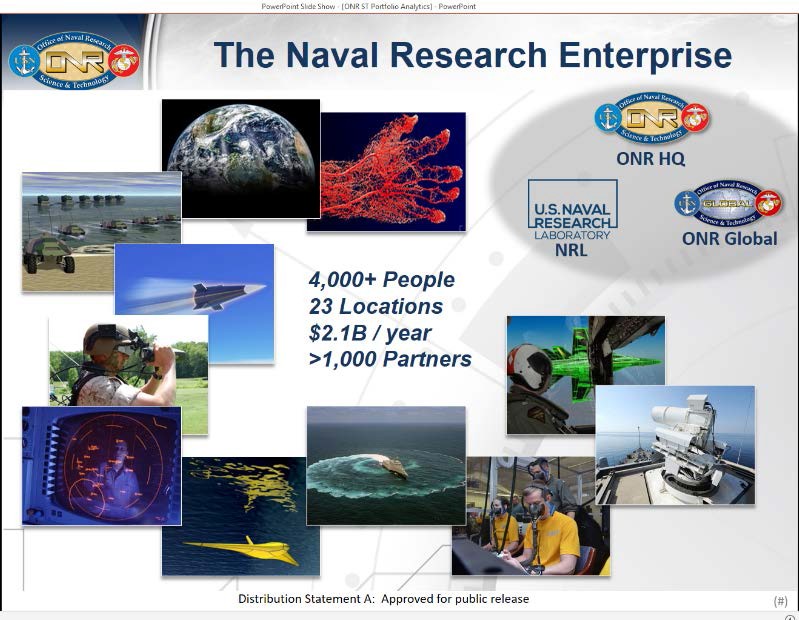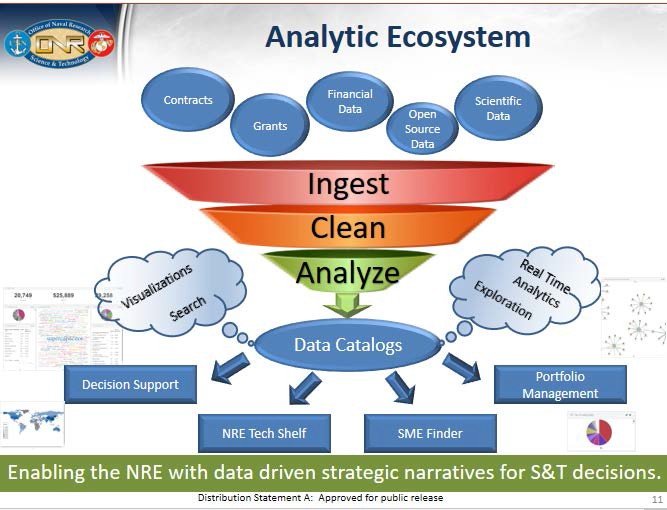Data Standdown: Interrupting process to fix information
Overview
Although not a true pause in operations, ONR’s data standdown made data quality and data consolidation the top priority for the entire organization. It aimed to establish an automated and repeatable solution to enable a more holistic view of ONR investments and activities, and to increase transparency and effectiveness throughout its mission support functions. In addition, it demonstrated that getting top-level buy-in from management to prioritize data can truly advance a more data-driven culture.
Source
Category
Keywords
Details
Originally published May 10, 2019
Rear Admiral David J. Hahn, Chief of Naval Research at the Office of Naval Research (ONR), called for ONR’s first-ever data standdown in May 2018. In military operations, a commander may halt all operations for a safety standdown to review and reinforce tactics, techniques, and procedures, and to reduce operational safety risks. Although not a true pause in operations, ONR’s data standdown made data quality and data consolidation the top priority for the entire organization. It aimed to establish an automated and repeatable solution to enable a more holistic view of ONR investments and activities, and to increase transparency and effectiveness throughout its mission support functions. In addition, it demonstrated that getting top-level buy-in from management to prioritize data can truly advance a more data-driven culture.
The Data Challenges
ONR’s Data & Analytics Division provides analysis of the Naval Research Enterprise (NRE) portfolio in order to enhance mission effectiveness for U.S. Naval Forces. ONR supports more than 4,000 personnel across 23 locations, with more than 1,000 partners.

Until recently, data for planning, programming, budgeting, and execution (PPBE) have been siloed. Information originating from these disparate systems and business processes were often inconsistent, with no easy way for users to conduct cross-functional analysis.
A clear understanding of the ONR Research & Development (R&D) portfolio would require clean and connected data. But data fragmentation and inconsistency made it extremely difficult to establish a single view of the ONR R&D portfolio, not to mention track a research project through its entire lifecycle. Each data call was resource intensive, requiring multiple data sources throughout the command and considerable time to complete. Furthermore, there was no process in place to catalog results from data calls for reuse by others.
The Data Standdown
In response to the ongoing challenges posed by ONR’s data stovepipes, the Chief of Naval Research announced a 4-month data standdown from May to August 2018.
The standdown was communicated widely, helping to ensure that colleagues from other offices would be ready to step in when the Data & Analytics team needed help understanding information. The standdown broadly elevated system interoperability issues and data concerns and gave the Data & Analytics team license to make changes to information systems and the business practices that interact with them.
During the exercise, the Data & Analytics team routinely presented data to the entire command, highlighting inconsistencies and other issues that required a resolution from programmatic staff. For example, before the standdown, the same program had three different descriptions in three different systems, leading to confusion over documentation. The team presented this issue to the entire command and asked each program area to provide its own, authoritative description. The old program descriptions were deleted from all three systems, and the newly collected program descriptions were ratified as the official sources. The team created a standard operating procedure for reviewing, adding to, and archiving these program descriptions in a way that would maintain consistency across systems.
Executing with a clear vision and an iterative approach
For ONR’s Data & Analytics team, success meant establishing an automated and repeatable solution for generating an end-to-end picture of the ONR R&D portfolio over time. With such an ambitious vision as their North Star, the team had to be careful to make each phase of work an achievable quantity.

In Phase 1, the team focused on ONR’s Science and Technology (S&T) domain, assembling a five-year snapshot that would integrate departmental funding and individual research awards associated with the portfolio.
The team stayed within the same domain area S&T for Phase 2, but expanded the type of data they worked with to include acquisition, records management, and performance-related data assets. Data & Analytics worked with the corresponding offices to determine what documents they could contribute to the R&D process, where those documents are stored, how to link those locations to a web search tool, and what indexing approaches would work best.
Bit by bit, the team organized data so that it could be funneled into a web tool facilitating search and retrieval of research award related documents. The tool represented an important wrung on the ladder to an all-encompassing PPBE view, but it also served another important function - it allowed the team to share its work with a much larger group of stakeholders, who could then pitch in to help highlight inconsistencies and errors.
The data standdown played a critical role in focusing the entire command on the importance of clean and connected data to our R&D mission. Getting a better understanding of our data is critical to helping us achieve a holistic view of our portfolio. Modifying our business processes has enabled us to move toward a data-driven culture that supports ONR investments and priorities.
— Dr. David E. Walker, Research and Development Portfolio Director, Office of Naval Research
Fix the present, but keep the future in mind
The Data & Analytics team’s work through the standdown led to many gains, large and small. The greatest value came from understanding the scope of complexity that unifying research data really entails. But the exercise also allowed the team to prioritize efforts going forward. It brought visibility to the data challenges facing ONR, and recruited employees from diverse parts of the enterprise to help execute the mission, thus helping a more data-driven culture flourish. Matt Poe, head of the Data & Analytics Division, noted that these are just interim results. He said, “We must apply the lessons we learn from the data standdown and the time we spend stitching together our stovepipe PPBES processes to the business process modeling and new electronic business solutions ONR plans to implement in future.”
Postscript
To learn more about ONR’s data standdown, you may contact Matthew Poe, the Director of the Data & Analytics Division or Dr. Ryan Zelnio, Chief Analytics Officer at ONR. Their email addresses are Matthew.D.Poe@navy.mil and Ryan.J.Zelnio@navy.mil, respectively.
To receive updates on activities related to the Federal Data Strategy, please sign up for the newsletter.
The Federal Data Strategy Incubator Project
The Incubator Project helps federal data practitioners think through how to improve government services, enabling the public to get the most out of federal data. This Proof Point and others will highlight the many successes and challenges data innovators face every day, revealing valuable lessons learned to share with data practitioners throughout government.
Guidance references
- FDS Practice 01 Identify Data Needs to Answer Key Agency Questions
- FDS Practice 02 Assess and Balance the Needs of Stakeholders
- FDS Practice 04 Use Data to Guide Decision-Making
- FDS Practice 07 Use Data to Increase Accountability
- FDS Practice 11 Prioritize Data Governance
- FDS Practice 17 Recognize the Value of Data Assets
- FDS Practice 28 Align Quality with Intended Use
- FDS Practice 30 Communicate Planned and Potential Uses of Data
- FDS Practice 32 Harness Safe Data Linkage
- FDS Principle 05 Harness Existing Data
- FDS Principle 07 Demonstrate Responsiveness

